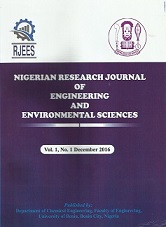Modelling and Optimization of Luffa cylindrica Fibre Pyrolysis Process using Response Surface Methodology
Authors: *Ugwuodo, C.B., Itiri, H.U., Oyedoh, E.A. And Emmanuel, I.N.
DOI Info: http://doi.org/10.5281/zenodo.15778125
ABSTRACT
The pyrolysis of Luffa cylindrica fibre, an agricultural waste, was carried out to model and optimize the bio-oil produced using RSM. The physicochemical behaviour of the material was investigated. The fixed-bed pyrolysis reactor was utilized to decompose the Luffa fibre to produce bio-oil. The elemental composition results showed the presence of C (46.50 wt %), H (6.20 wt %), N (0.20 wt%), O (37.60 wt%), and S (0.91 wt%). The fixed-bed pyrolysis reactor produced an optimum bio-oil of 22.0053 wt% at temperature (604.86 oC), inert gas flow (1.16 L/min), and particle size (4.87 mm). The Response Surface Methodology (RSM) via Box Behnken Design (BBD) was employed to model and optimise the operating parameters. P<0.5, a high F-value for bio-oil makes the established model predicted, suitable, responsive, and reliable. The actual and predicted value for the quantity of bio-oil produced showed clearly that the data is reasonably in consonance with the predicted value. Screening with FT-IR revealed peaks attributed to O–H stretching vibrations, depicting the presence of alcohol and carboxylic acids, respectively and the peak of C–H bend and C–O stretch, indicating the presence of aromatic compounds and aromatic ester. Hence, the bio-oil produced is suitable for high-speed diesel engines, powering heavy machines, marine equipment, manufacturing industries, and mining types of machinery.
Affiliations: Department of Chemical Engineering, College of Engineering and Engineering Technology, Michael Okpara University of Agriculture, Umudike, Nigeria.
Keywords: Bio-oil, BBD, Luffa Cylindrica, Fibre, Optimization, RSM
Published date: 2025/06/30









